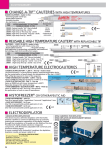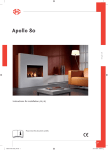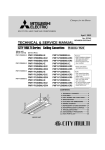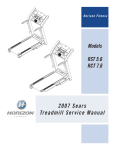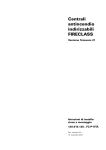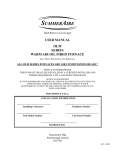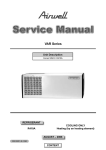Download Summeraire Mfg. Peterborough, Ontario, Canada
Transcript
Built Better To Last Longer Residential Central Heat Recovery Ventilator Product Specifications and Installation and Trouble Shooting Guide Superventor Series Models SHRV115RD, SHRV130RD, SHRV190RD, SHRV240RD APPLICATION WARNING It is always important to assess how the operation of any Heat Recovery Ventilator (HRV) may interact with vented combustion equipment (i.e. gas furnaces, oil furnaces, wood stoves, fireplaces. etc.) Never install an HRV in a situation where it’s normal operation, lack of operation, or partial failure may result in the back drafting on vented combustion equipment such as water heaters, furnaces and fireplaces DO NOT ATTEMPT INSTALLING THIS HRV WITHOUT FIRST READING THIS ENTIRE MANUAL Summeraire Mfg. Peterborough, Ontario, Canada, K9J 6X6 Table of Contents Model specifications . . . . . . . . . . . . . . 3, 4, 5, 6 Option Controls . . . . . . . . . . . . . . . . . . . . . 7 Selecting a Location . . . . . . . . . . . . . . . . . . 11 Weather hood installation. . . . . . . . . . . . . . . .13 Dedicated Duct system . . . . . . . . . . . . . . . . 14 Indirect Duct system . . . . . . . . . . . . . . . . . 15 Direct Duct system . . . . . . . . . . . . . . . . . . 16 Fresh Air supply ducting . . . . . . . . . . . . . . . 17 Stale Air return system . . . . . . . . . . . . . . . . 18 Air Flow Balancing . . . . . . . . . . . . . . . . . . 18 Trouble shooting guide . . . . . . . . . . . . . . . . 21 Wiring Diagrams . . . . . . . . . . . . . . . . . 28, 29 Replacement parts list . . . . . . . . . . . . . . . . . 30 NOTE: Anytime the HRV is powered on allow 20 seconds for the main control to reset prior to making any operational changes. SPECIFICATIONS HEAT RECOVERY VENTILATORS PERFORMANCE RATINGS MODEL: SHRV115RD Electrical: 120 V - 1.12 Amp Exhaust Air Transfer Ratio: 0.04 @ 0.4 in wg. (100 Pa) Low Temp. Reduction Factor: 17.8% Supply - 13.8% Exhaust Low Temp. Imbalance Factor: 0.86 VENTILATION PERFORMANCE %XT$IFFERENTIAL0RESSURE0ASCALS EXT. STATIC PRESSURE Pa in. wg 25 0.1 50 0.2 75 0.3 100 0.4 125 0.5 150 0.6 175 0.7 200 0.8 225 0.9 250 1.0 NET SUPPLY AIR FLOW L/S CFM 71 151 65 138 60 127 55 117 50 107 45 96 41 87 36 76 32 68 24 52 GROSS AIR FLOW SUPPLY EXHAUST L/S CFM L/S CFM 74 157 64 136 68 144 61 130 62 133 58 123 57 122 55 117 52 111 52 110 47 100 48 102 43 90 44 94 37 79 41 87 33 70 37 79 26 54 34 72 14 1/4 20 ALL DUCT CONNECTIONS 6 IN. (152MM) STALE AIR FROM HOUSE FRESH AIR FROM OUTSIDE FRESH AIR TO HOUSE STALE AIR TO OUTSIDE 28-1/4 'ROSS!IRFLOW,3 Gross Supply Gross Exhaust #UBIC&EET0ER-INUTE#&- ENERGY PERFORMANCE SUPPLY TEMPERATURE C° 0 HEATING 0 0 -25 F° +32 +32 +32 -13 C NET AIR FLOW L/S CFM 30 63 46 98 55 118 32 69 US SUPPLY EXHAUST FLOW RATIO 1.03 1.00 1.00 .91 POWER CONSUMED WATTS 80 118 136 102 SENSIBLE RECOVERY EFFICIENCY 68 63 61 59 APPARENT SENSIBLE EFFECTIVENESS 82 74 71 82 LATENT RECOVERY/ MOISTURE TRANSFER 0.01 0.02 0.02 .04 SUMMERAIRE MFG., PETERBOROUGH, ONTARIO K9J 7B1 Home Ventilating Institute SPECIFICATIONS HEAT RECOVERY VENTILATORS PERFORMANCE RATINGS MODEL: SHRV130RD Options Installed: Defrost Internal Dehumidistat Electrical: 120 V - 1.27 Amp Exhaust Air Transfer Ratio: .02 Low Temp. Ventilation Reduction During -25°C Test: 20% Maximum Unbalanced Airflow During -25°C Test: 7 L/s VENTILATION PERFORMANCE EXT. STATIC PRESSURE Pa in. w.c. 25 0.1 50 0.2 75 0.3 100 0.4 125 0.5 150 0.6 NET SUPPLY AIR FLOW L/S CFM 98 209 92 196 86 182 79 169 68 145 58 124 GROSS AIR FLOW SUPPLY EXHUAST L/S CFM L/S CFM 100 213 92 196 94 199 87 186 87 186 82 174 81 172 76 162 70 148 70 148 59 126 60 127 17 3/4 20 3/4 Ext. Differential Pressure - Pascals (IN W.C. = PA ÷ 250) 200 175 150 125 100 75 50 Supply 25 Exhaust 0 20 STALE AIR FROM HOUSE FRESH AIR FROM OUTSIDE FRESH AIR TO HOUSE STALE AIR TO OUTSIDE 36 40 60 80 100 120 Gross Airflow - L/s (CFM = L/s ÷ .47) ENERGY PERFORMANCE SUPPLY TEMPERATURE C° 0 HEATING 0 0 -25 F° 32 32 32 -13 NET AIR FLOW L/S CFM 30 64 46 97 61 129 31 66 95 31 POWER CONSUMED WATTS 83 104 117 95 SENSIBLE RECOVERY EFFICIENCY 71 67 66 58 APPARENT SENSIBLE EFFECTIVENESS 82 77 73 79 LATENT RECOVERY/ MOISTURE TRANSFER 0.01 0.00 0.00 0.03 TOTAL RECOVERY EFFICIENCY COOLING 35 65 83 SUMMERAIRE MFG., PETERBOROUGH, ONTARIO K9J 6X6 18 SPECIFICATIONS HEAT RECOVERY VENTILATORS PERFORMANCE RATINGS MODEL: SHRV190RD Options Installed: Defrost Internal Dehumidistat Electrical: 120 V - 1.27 Amp Exhaust Air Transfer Ratio: 0.014 Low Temp. Ventilation Reduction During -25°C Test: 16% Maximum Unbalanced Airflow During -25°C Test: 14 L/s VENTILATION PERFORMANCE EXT. STATIC PRESSURE Pa in. w.c. 25 0.1 50 0.2 75 0.3 100 0.4 125 0.5 150 0.6 175 0.7 NET SUPPLY AIR FLOW L/S CFM 110 234 106 226 102 217 98 209 92 197 86 183 79 169 GROSS AIR FLOW SUPPLY EXHUAST L/S CFM L/S CFM 112 237 105 223 108 229 100 214 103 220 95 203 100 212 88 187 94 200 82 175 87 185 74 157 81 171 61 129 17 3/4 20 3/4 Ext. Differential Pressure - Pascals (IN W.C. = PA ÷ 250) 225 200 175 150 125 100 75 Supply 50 FRESH AIR FROM OUTSIDE FRESH AIR TO HOUSE STALE AIR TO OUTSIDE Exhaust 25 0 STALE AIR FROM HOUSE 36 20 40 60 80 100 120 Gross Airflow - L/s (CFM = L/s ÷ .47) ENERGY PERFORMANCE SUPPLY TEMPERATURE C° 0 HEATING 0 0 -25 F° 32 32 32 -13 NET AIR FLOW L/S CFM 40 84 66 140 86 182 34 72 95 42 POWER CONSUMED WATTS 103 132 158 116 SENSIBLE RECOVERY EFFICIENCY 68 62 58 61 APPARENT SENSIBLE EFFECTIVENESS 77 68 64 79 LATENT RECOVERY/ MOISTURE TRANSFER 0.01 0.00 0.00 0.03 TOTAL RECOVERY EFFICIENCY COOLING 35 89 104 SUMMERAIRE MFG., PETERBOROUGH, ONTARIO K9J 6X6 29 SPECIFICATIONS HEAT RECOVERY VENTILATORS PERFORMANCE RATINGS MODEL: SHRV240RD Options Installed: Defrost Internal Dehumidistat Electrical: 120 V - 3.7 Amp Exhaust Air Transfer Ratio: 0.05 Low Temp. Ventilation Reduction During -25°C Test: 16.9% Maximum Unbalanced Airflow During -25°C Test: 15.6 L/s VENTILATION PERFORMANCE EXT. STATIC PRESSURE Pa in. w.c. 75 0.3 100 0.4 125 0.5 150 0.6 175 0.7 200 0.8 225 0.9 250 1.0 275 1.1 300 1.2 NET SUPPLY AIR FLOW L/S CFM 125 265 121 257 118 251 116 246 113 240 110 235 106 226 100 212 94 200 86 183 GROSS AIR FLOW SUPPLY EXHUAST L/S CFM L/S CFM 133 283 138 294 129 274 131 279 126 268 125 266 123 262 119 254 120 256 114 243 118 251 110 234 114 241 102 217 106 226 96 205 101 214 92 196 92 195 86 182 25-7/8 ALL DUCT CONNECTIONS 6 IN. (152MM) 325 300 Ext. Differential Pressure - Pascals (IN W.C. = PA ÷ 250) 16 275 250 225 200 175 150 125 100 75 Supply STALE AIR FROM HOUSE FRESH AIR FROM OUTSIDE FRESH AIR TO HOUSE STALE AIR TO OUTSIDE Exhaust 34-1/2 50 80 90 100 110 120 130 140 150 Gross Airflow - L/s (CFM = L/s ÷ .47) ENERGY PERFORMANCE SUPPLY TEMPERATURE C° 0 HEATING 0 0 -25 F° 32 32 32 -13 NET AIR FLOW L/S CFM 46 97 67 141 100 213 41 88 POWER CONSUMED WATTS 176 222 400 213 SENSIBLE RECOVERY EFFICIENCY 69 70 64 66 APPARENT SENSIBLE EFFECTIVENESS 86 84 80 87 SUMMERAIRE MFG., PETERBOROUGH, ONTARIO K9J 6X6 LATENT RECOVERY/ MOISTURE TRANSFER 0.00 0.01 0.01 0.03 OPTIONAL CONTROLS 20 Minute Remote Timer Touch Pad Model ECPBT This 20-Minute Touch Pad MUST be connected to the “CT” terminals on the HRV exterior. This control will not function if connected to PBT connection points. Install using 18/2-thermostat wire. Maximum number of ECPBT controls per HRV is eight. Maximum cumulative lead length is 2000 lineal feet. Touch pads are typically installed where 20 minutes of high speed ventilation may be desired. Once activated by a momentary push of the SELECT button on the Touch Pad (approximately 3 seconds), the HRV is switched to high speed ventilation and the Touch Pad LED will illuminate. The HRV will reset to the previously selected mode of operation once the 20 minutes have expired. To cancel the selection, depress the SELECT button on the 20-minute Touch Pad for a minimum of 3 seconds. The selection can also be cancelled at any other optional control by momentarily depressing the SELECT button. NOTE: This control will not respond while a crank timer is operational. OPTIONAL CONTROLS Remote Timer Touch Pad Model -PBT Touch pads are typically installed in any room where 20/40 or 60 minutes of high-speed ventilation may be desired, i.e. bathrooms and/or kitchens. Once activated by a momentary push, these buttons illuminate to indicate high speed activation. If more than one touch pad is installed in the system then all will illuminate upon activation until the timed sequence has expired. The display LEDS on the touch pad will illuminate to represent the time remaining. To cancel a selection simply continue to push the select button until it turns off. Maximum number of touch pads per HRV is eight (8) and 2000 lineal ft of 18/2 thermostat wire. Wall Mount Dehumidistat Model - SRDEH This control is typically installed in an area of the home where humidity may require automatic monitoring. This could be a central location (i.e. near furnace thermostat) or in a specific room (i.e. kitchen, laundry etc.). When wall mount dehumidistats are used, set the HRV internal dehumidistat to OFF. Connect to HRV using 18/2 thermostat wire. Scout Control This standard control is detachable from the HRV. Once removed from the HRV, only the power (ON/OFF) remains at the HRV. By positioning the SCOUT remotely to the HRV, you can adjust fans speeds, turn the fan off, select AUTO/OFF, intermittent or turn the main HRV control Off. When the HRV has been turned off using the SCOUT, power still remains on at the HRV ON/OFF switch, however all external controls such as touch pads and dehumidistats will not function. Intermittent- In this mode the ventilation fan will run at low speed for 20 minutes and turn off for 40 minutes. This cycle will continue until cancelled. External devices are active. The optional Scout installation kit is required for remote mounting. Maximum number of Scout controls per HRV is one (1) with up to 400 lineal ft. of 18/2 thermostat wire. WATCHMAN CONTROL The WATCHMAN is an optional intermediate remote control. It permits the following function selections; SYSTEM OFF- In this position all internal and external controls are disabled. FAN OFF- Ventilation fan is off, cold exhaust port is closed, external devices are active. FAN SPEED- Low, Medium or HIGH can be selected. INTERMITTENT- In this mode the ventilation fan will run at low speed for 20 minutes and turn off for 40 minutes. This cycle will continue until cancelled. External devices are active. AUTO/OFF-In this mode the ventilation fan remains off until activated by either the internal dehumidistat or an external control such as a touch pad or dehumidistat. RELATIVE HUMIDITY- By rotating the control dial you can select desired levels of indoor humidity. Humidity reduction will only occur during the heating season. Should the set point be below the indoor relative humidity the HRV will automatically switch to high speed. Multiple controls may be connected to the HRV. Typically, connection leads would be distributed from a central location and connected at the HRV with a single 18/2 lead. Maximum number of Watchman or Sentinel controls per HRV is four (4) with a total of 1600 lineal ft. of 18/2 thermostat wire. SENTINEL CONTROL The SENTINEL control is the deluxe control using a digital LCD display to indicate HRV status. The top line of the display indicates the current mode of operation, the lower left side indicates the ventilation fan status and the lower right hand side indicates the current relative humidity. The following option selections are available in addition to those offered by the WATCHMAN; TIMED HIGH SPEED- 20/40 or 60 minutes of high speed ventilation can be selected or cancelled. FILTRATION- In this mode the HRV fan runs continuously recirculating indoor air through the HRV filters. During this cycle the outdoor cold air port is closed and no fresh air is introduced. CLEAN FILTER INDICATOR- Every thirteen weeks this control will display on the LCD the need to clean the filters and core. Refer to the maintenance section of the User manual for the method advised. Maximum number of Watchman or Sentinel controls per HRV is four (4) at a maximum range of 1600 lineal ft. of 18/2 thermostat wire. SCOUT / WATCHMAN Indications MODE SCOUT WATCHMAN Intermittent Fan Off Auto Off, Blink Intermittent LED ON, Blink Auto Off Intermittent Fan Low Low, Blink Intermittent LED ON. Blink Low Filtration Default fan speed, Slow Blink Default fan speed, Slow Blink Summer Switch on Temp <5deg˚F System Off, Blink System Off, Blink Note: Up to 2000 lineal ft. of 18/2 thermostat wire may be used in any configuration per HRV with up to eight (8) push button timers.Up to 2000 lineal ft. of 18/2 thermostat wire may be used in any configuration per HRV to service up to four (4) Watchman or Sentinel controls. 10 Model SHRV 130RD Illustrated Air In Filtered Air Out Filtration Installation Options Warm Exhaust Cold Supply Warm Supply Cold Exhaust Cold Exhaust Warm Supply Cold Fresh Air Supply Standard Ventilation Warm Stale Exhaust Optional Ventilation 1. Selecting a location Typically the HRV is located in the mechanical room with close proximity to an outside wall. Other installation locations are acceptable provided that the ambient air temperature does not fall below freezing. This is to prevent the condensate drain lines from freezing. 11 2. Mounting the HRV The RD series of HRV’s may be rotated 180 degrees to permit the connection of the outside air streams to either the left or right hand side. They are factory supplied to be installed with the cold air streams on the right. To install this HRV in the reverse configuration simply remove the plastic drain hole plugs from the top of the cabinet and insert into the drain holes in the bottom. Included with the HRV are four (4) laminated rubber hanging straps. These are to be secured at each of the four corners of the HRV using the screws provided. The other ends of the straps should be secured to the floor joists using large head screws. To ensure proper condensate flow, HRV must be installed level in both directions. 3. Condensate Drain hose installation Two (2) drain spigot assemblies are provided. These are to be installed through the drain pan holes provided. Simply install the spigot through the openings and secure in place by installing the nylon washer and nut on the outside of the cabinet. Ensure that the drain holes that are not used are plugged with the drain plugs installed in the cabinet. Once installed, attach 1/2” plastic tubing (not supplied) to the spigots. Create a trap by forming a loop in the tubing. This will prevent the cross contamination of the air streams through the tubing. Ensure that the condensate drain tubing is not exposed to freezing temperatures. Typically the drain line is connected into a floor drain, sink or stand pipe. Drain Opening Plugs Create Trap 12 4. Outside Weatherhoods and Ducting to the outside. Inner Liner Weatherhood Collar Insulation Clamp Vapour Barrier The outside weather hoods must have built in bird screens to prevent birds and rodents from entering the duct system. Minimum mesh size of 1/4” must be used. Smaller mesh size will result in restricted air flows with increased potential for the development of blockages. Vent hoods with gravity dampers must not be used. Weather hoods should be installed: a) b) c) d) A minimum of 6 ft. apart from each other. At least 18” above ground level Away from sources of contaminates such as automobile exhaust fumes, gas meters, garbage cans. Locate away from prevailing winds whenever possible. The size and design of the weather hoods shall be selected to ensure adequate free area to minimize air flow restrictions. It is recommended that 6” insulated ducting with a integral single piece vapour barrier be provided. Due to the high air flow restrictions in insulated flex duct it is recommended that run lengths be kept to a minimum, stretched tightly and with as few elbows as possible, if length greater 25 ft. use 7” insulated duct. Minimum RSI value of 0.75 (R4) is required. Weather hood collar should be screwed to inner surface of sill plate and sealed with high quality caulking or aluminum faced tape. Both the inner and outer liners of flexible ducting should be securely attached to the weather hood tubing and collar and to the HRV collar. A good bead of high quality caulking (preferably acoustical sealant) should be used prior to clamping the liners. It is very important to ensure that the fresh air intake line is well sealed and that the vapour barrier is sealed. 13 5. Installation Methods Dedicated Duct System. In this arrangement the HRV is installed with a dedicated duct system. All applicable rooms are exhausted and provided with fresh supply air as required. The main advantage of this type of installation is it provides the ability to balance the exhaust and supply air streams from each serviced room. The HRV system operates independent of the home’s heating system. Please refer to fig I. below. Stale Air Exhaust Fresh Air Exhaust Air Fresh Air In fig. I 14 Indirect Duct System Safety Warning Some Building Code and Combustion Appliance Installation Codes do not allow location of return air grills or any opening such as a breather ‘T’ in an enclosed room with spillage susceptible combustion appliances. If combustion appliances are used, and not yet enclosed in a room, locate the grill or breathing ‘T’ outside any future wall locations and a minimum distance of 6 feet from the combustion appliance. This method of installation permits localized exhaust of indoor air and uses the existing forced air system to distribute fresh air. Although independent room balancing of exhaust air can be achieved with the indirect duct system, the distribution of fresh supply air cannot be balanced. Where required by local codes, the HRV/ERV supply duct may be directly connected to the furnace return air duct. The supply duct shall be positioned as shown on the attached drawing. In this application no opening such as a breather ‘T’ is used. Also, where permitted by local codes, the HRV/ERV supply duct may be indirectly connected to the furnace return air duct using a breather ‘T’. In this application, the breather ‘T’ in installed into the HRV/ERV supply duct before the connection to the return air duct. Leaving a gap in the ventilation supply duct in place of the breather ‘T’ is acceptable but not recommended. In this installation, a grill is placed in the furnace return air duct and the HRV/ERV supply duct is pointed at this grill at a minimum distance of 100mm (4”) but not greater than 300mm (12”). The free area of the grill shall not be less than the free area of the supply duct. Call backs have occurred because it was thought that something had been accidently left out of the installation. This method of installation requires that the forced air circulation fan be operated when the HRV is in use. Stale Air Exhaust Please refer to fig II. below. Minimum 36" Breathing "T" Fresh Air Supply fig. II Fresh Air In Stale Air Out 15 Direct Duct System Safety Warning Some Building Code and Combustion Appliance Installation Codes do not allow location of return air grills or any opening such as a breather ‘T’ in an enclosed room with spillage susceptible combustion appliances. If combustion appliances are used, and not yet enclosed in a room, locate the grill or breathing ‘T’ outside any future wall locations and a minimum distance of 6 feet from the combustion appliance. This method of installation is used primarily when it is not reasonable to install dedicated duct runs from the HRV to the various rooms of the dwelling. In this installation the warm exhaust and warm supply duct runs from the HRV are connected directly to the forced air heating system ductwork. This method of installation does not permit source capture of the indoor air nor does it permit room balancing. Where required by local codes, the HRV/ERV supply duct may be directly connected to the furnace return air duct. Where both the exhaust and the supply duct are installed into the return air duct the exhaust air duct shall be positioned upstream at a distance of not less than 1 meter (or 3 feet) from the supply duct. The supply duct shall be positioned as shown on the attached drawing. In this application no opening such as a breather ‘T’ is used. Also, where permitted by local codes, the HRV/ERV supply duct may be indirectly connected to the furnace return air duct using a breather ‘T’. In this application, the breather ‘T’ in installed into the HRV/ERV supply duct before the connection to the return air duct. Leaving a gap in the ventilation supply duct in place of the breather ‘T’ is acceptable but not recommended. In this installation, a grill is placed in the furnace return air duct and the HRV/ERV supply duct is pointed at this Stale Air grill at a minimum distance Exhaust of 100mm (4”) but not greater than 300mm (12”). The free fig. III area of the grill shall not be less than the free area of Minimum 36" the supply duct. Call backs have occurred because it was thought that something had been accidently left out of the Breathing "T" Fresh Air Supply installation. The Direct Duct System method of installation requires that the forced air system circulation fan be operated when the HRV is in use. Please refer to fig. III. Fresh Air In 16 Stale Air Out 6. Interior Ducting Ducting to the central forced air ductwork system, or if used, a dedicated duct system, should be made of galvanized metal whenever possible. To minimize airflow losses, runs should be kept as short as possible using 45 degree elbows instead of 90 degree. Whenever possible use “Y” fittings instead of “T” fittings. All joints must be fastened with screws, rivets or duct sealant and wrapped with a quality duct tape to prevent leakage. If standard grills are used, it is recommended that wall grills of not less than 6” x 12” and floor grills of no less than 4” x 10” be used to minimize air flow restrictions. 7. Fresh Air Supply Ducting Fresh air supply ducting to the living space may be either a dedicated or an indirect duct system. Please refer to figures I and II. Should the indirect method be used it is suggested that at the point of connection to the HRV that a short length of flex duct be used to electrically isolate the two systems. Fresh air supply grills may be either wall or ceiling mounted. Avoid locating these grills where room occupants may be exposed to the fresh air supply as this air temperature may be slightly less than the room air temperature. Also, it is recommended that adjustable grills such as round “Tech Grills” be used to permit balancing of the ventilation by room application. It is recommended that a breathing “T” be installed in the fresh air duct between the HRV and the central distribution system. This will maximize efficiency, but hard connection is acceptable. 17 8. Stale Air Return System The stale air return system is used to extract humid, stale air from the areas of the dwelling where the worst air quality conditions might exist. These may include areas such as laundry rooms, bathrooms and kitchens. Note that C.S.A. Standard F326 requires that air be exhausted from each room with a forced air furnace. Wall stud spaces can be used as ducting for high wall returns provided that they are lined with galvanized metal. Note: Check local code compliance before implementing. Adjustable “Tech Grills” are recommended for use in the return air system. They can be wall or ceiling mounted thereby permitting balancing of the air being exhausted. Stale air return grills should be located at opposite ends in the room to the fresh air grills to ensure good air exchange. Please note that the exhaust air stream from a kitchen area must never be connected to the kitchen range hood. Instead an exhaust grill should be mounted high on the wall as required by local codes so as not to extract cooking by products. 9. Air Flow Balancing READ THE APPLICATION WARNING AT THE FRONT OF THIS MANUAL. A magnehelic gauge and pilot tube flow measuring system is used for easy and accurate air flow measurement Upon completion of the installation it is necessary that the Ventilation System be balanced. This is necessary to ensure that the volume of air being exhausted from the dwelling is equal to the volume of air being supplied. Balancing will also ensure that the HRV is operating at it’s maximum efficiency. Detailed check list to be carried out prior to balancing. a) b) c) d) e) Install air flow station in each of the warm air streams. Ensure that all ductwork is secured and sealed. Drain connections are in place and drain trap filled with water. Dwelling vapour barrier is complete and intact. Fireplace dampers, windows and doors are closed. 18 f) Clothes dryer off, (if vented to the outdoors) g) Furnace, hot water heater, (non direct vent) are turned off. h) All other exhaust fans are off. i) Ensure that HRV filters and core are in place and integral balancing dampers are wide open. j) Power up HRV and set to high speed. k) Adjust all branch tech grills and registers to desired air flows. l) After taking readings at both the stale air being exhausted and the fresh air supply air stream, damper down the higher air flow stream with the integral balancing damper to equal the lower volume air stream. m) Once the air flows are balanced lock the balancing dampers in place. n) While it is necessary to ensure that both air streams are balanced within 10% of each other, a near balanced condition should be possible. o) Upon completion, return the fan speed selection to the normal speed of low. A positive pressure situation within the dwelling may drive moist air into the external walls of the dwelling where, in cold weather, it may condensate, potentially causing structural damage. A negative pressure within the dwelling may have severe undesirable effects. In some geographic locations, radon gas may be drawn into the living space. A negative condition may also cause back drafting of vented combustion appliances such as fireplaces and furnaces. When it is possible for excessive pressurization or depressurization of a dwelling to occur it may be necessary to perform a House Pressure Test. This test is most important where fuel fired devices are installed that are susceptible to spillage. IT IS YOUR RESPONSIBILITY TO DETERMINE IF THE “HOUSE PRESSURE TEST” IS REQUIRED. 19 Summeraire HRV Air Flow Balancing A. Preliminary Procedures: 1. Seal all the unit’s ductwork with foil tape. 2. Close all windows and doors and fireplace damper, turn off all exhaust devices (range hoods, clothes dryer, bath fan, etc.), make sure all filters are clean. 3. Set build-in balancing dampers fully open. Tap 1/8” hole in ductwork for pitot tube insertion. B. Balancing Procedures: 1.Set HRV to high speed. Make sure that the furnace blower is ON if the installation is in any way connected to the ductwork of the furnace. If not, leave the furnace blower OFF. Adjust air flow in branch lines if using source point exhaust and/or supply. 2. If outside temperature is below -3°C (26°F), make sure defrost light is not on while balancing. 3. Place magnahelic gauge on a level surface and adjust it to zero. Insert pitot tube into exhaust air ductwork with tip aligned with ductwork, pointing away from HRV, into air flow. Record the reading on gauge. 4. Move kit to other air stream HRV, insert pilot tube into fresh air ductwork with tip aligned with ductwork, pointing towards HRV , into air flow. Record reading on gauge. Adjust fresh air balancing damper until reading is approximately the same as in exhaust air ductwork. If the reading in the fresh air ductwork is less than in the exhaust air, go back and adjust the exhaust balancing damper to equal the fresh air flow. 5. Secure dampers in place with fastening screw. Duct tape over pitot tube holes.Convert FPM reading on gauge to CFM with conversion chart and record on balancing sticker and affix to HRV near label. 6. Note: Unit is considered balanced if readings are within +/- 10%. 20 21 HUMIDITY LEVEL TOO HIGH HUMIDITY MAY HAVE TO BE ARTIFICIALLY ADDED, i.e. HUMIDIFIER. ADJUST TO LOWER FAN SPEED OR INTERMITTENT LIFE STYLE OF OCCUPANTS. VENTILATION RATE TOO HIGH HRV UNDERSIZED. BALANCE HRV SET DEHUMIDISTAT TO A HIGHER SET POINT. DEHUMIDISTAT CONTROL SET TO LOW. HRV AIR FLOWS IMPROPERLY BALANCED BALANCE HRV HRV AIR FLOWS IMPROPERLY BALANCED. REPLACE. INSPECT CONNECTION BETWEEN MOTOR SHAFT AND DAMPER, COUPLING MAY BE LOOSE. DEFECTIVE DAMPER MOTOR. HUMIDITY LEVEL TOO LOW IF DAMPER DOOR DOES NOT OPERATE DURING “START UP SELF DIAGNOSTIC” BUT POWER LIGHTS ARE ON, BOARD MAY REQUIRE REPLACEMENT. FAILED MAIN CONTROL BOARD. FRESH AIR DUCT FROZEN OR VERY COLD (DEFROST LIGHT COMES ON) . REPLACE. BROKEN DAMPER BLADE ASSY. ENSURE HRV IS ON CONTINUOUSLY. INCREASE FAN SPEED. BALANCE SYSTEM. IMPROPER VENTILATION RATE. DEFROST NOT WORKING. ADJUST DEHUMIDISTAT(S) TO CORRECT RH READING (see operation manual), ADJUST TO A LOWER SETTING. CHECK OPERATION OF DEHUMIDISTAT, IF DEFECTIVE, REPLACE. INSTALL A DEHUMIDISTAT IN LIVING AREA OF HOME. IMPROPER ADJUSTMENT OF DEHUMIDISTAT(S). PERSISTENT CONDENSATION ON WINDOWS SOLUTION PROBABLE CAUSE PROBLEM HRV TROUBLE SHOOTING GUIDE OPERATION GUIDE 22 AIR FLOWS ARE POOR CLEAN AND REINSTALL REMOVE OBSTRUCTIONS IN DUCT(S), HOODS AND GRILLS. 1/4” MESH ON OUTSIDE HOODS PLUGGED IMPROPERLY SIZED DUCTING BALANCE HRV. CHECK ORIENTATION LABEL ON FRONT OF CORE AND POSITION CORE CORRECTLY. HRV MAY NOT BE LEVEL HRV HEAT EXCHANGE CORE NOT INSTALLED PROPERLY FILTER/CORE PLUGGED UP CHECK WATER DRAIN CONNECTIONS. MAKE SURE WATER DRAINS PROPERLY FROM THE PAN(S) DRAIN LINES OBSTRUCTED HRV AIR FLOW IMPROPERLY BALANCED ENSURE “O” RINGS ON DRAIN SPIGOT SEATS PROPERLY LOOK FOR KINKS IN LINE. IF SUPPLY AIR IS INSTALLED INTO RETURN AIR OF FURNACE, FURNACE FAN NEEDS TO RUN CONSTANTLY TO DISTRIBUTE VENTILATION AIR COMFORTABLY. ENSURE THAT A BREATHER “T” IS INSTALLED IN SUPPLY DUCT. PREHEATER MAY BE REQUIRED. OUTDOOR TEMPERATURE EXTREMELY COLD. DRAIN PAN (S) PLUGGED LOCATE GRILLS HIGH ON WALLS OR UNDER BASEBOARDS. POOR LOCATION OF SUPPLY GRILLS. WATER IN BOTTOM OF HRV BALANCE HRV. HRV AIR FLOWS IMPROPERLY BALANCED. AVOID HANGING CLOTHES TO DRY INSIDE, AVOID STORING WOOD INSIDE AND VENT DRYERS OUTSIDE. LIFESTYLES OF OCCUPANTS SUPPLY AIR FEELS COOL COVER POOLS, HOT TUBS ETC. WHEN NOT IN USE. HRV UNDERSIZED TO HANDLE HOT TUB, INDOOR POOLS, ETC. BALANCE HRV NOTE: FROST BUILD UP IS EXPECTED ON CORES PRIOR TO INITIATING A DEFROST CYCLE. SET DEHUMIDISTAT TO A LOWER SETTING. DEHUMIDISTAT SET TOO HIGH HRV AIR FLOWS IMPROPERLY BALANCED SOLUTION PROBABLE CAUSE HRV AND/OR DUCTS FROSTING UP PROBLEM 23 HRV STATUS PANEL FLASHING HIGH CONTINUOUSLY FROST ON FRESH AIR INTAKE & STALE AIR EXHAUST FLEX WATER LEAKS CONDENSATION OR ICE BUILD UP IN INSULATED DUCT PROBLEM ADJUST DEHUMIDISTAT TO HIGHER SET POINT REPAIR SEAL OF ALL CRACKS AND TEARS VAPOUR BARRIER INCOMPLETE HRV INTERNAL DEHUMIDISTAT SET TO LOW INSTALL CORE CORRECTLY “FRONT” OF CORE HAS INSTALLATION INSTRUCTION LABEL INSTALL WITH LABEL FACING HRV DOOR OPERATE HRV ON LOWER SPEED ie. INTERMITTENT HRV CORE INSTALLED IN REVERSE LEVEL HRV REPLACE GASKETING DOOR GASKET DAMAGED EXCESSIVE WATER DUE TO NEW WET CONSTRUCTION WRONG APPLICATION OF HRV UNUSUALLY HUMID AMBIENT HRV NOT LEVEL TAPE ALL JOINTS ENSURE THAT VAPOUR BARRIER IS COMPLETELY SEALED INSPECT FAN WHEELS TO ENSURE THEY ARE TURNING FREELY UNDER SIZED HRV MALFUNCTION WITH HRV INCOMPLETE VAPOUR BARRIER AROUND INSULATED DUCT SOLUTION PROBABLE CAUSE 24 CONTROL FUNCTION POWER UP HRV, CLOSE DOOR SAFETY SWITCH, TURN POWER SWITCH TO ON. PLACE ONE LEAD OF VOLT METER ON KNOWN NEUTRAL AND THE OTHER ON TERMINALS ON BACK OF SWITCH, ONE AT A TIME. VOLTAGE READING SHOULD BE LINE VOLTAGE ON BOTH BLACK LEADS. IF NOT, THEN REPLACE SWITCH. CONFIRM NEUTRAL AT SWITCH LEAD WITH KNOW NEUTRAL DISCONNECT POWER TO HRV. IDENTIFY KNOWN NEUTRAL, POSITION ONE LEAD OF OHM METER ON KNOWN NEUTRAL AND OTHER AT NEUTRAL LEAD AT REAR OF SWITCH. IF NO READING THEN INVESTIGATE CONNECTION OF NEUTRAL LEAD WIRE. AND OUTPUT. IF NO READING THEN REPLACE FILTER. DEFECTIVE POWER SWITCH RESTART HRV. THIS WILL RESET THE ELECTRONIC CONTROL BOARD REMOVE MAIN ACCESS DOOR AND CONTROL COVER PLATE. APPLY POWER TO HRV AND CLOSE DOOR SWITCH AND TEST THE TWO LEADS ON BACK OF SWITCH, ONE SHOULD HAVE A READING. CLOSE DOOR SWITCH AND CHECK OTHER LEAD WITH METER AND KNOWN NEUTRAL. IF NO READING IS PRESENT THEN REPLACE SWITCH. DEFECTIVE DOOR SWITCH POWER OFF – UNPLUGGED FROM POWER SOURCE ENSURE THAT DOOR SWITCH IS OPERATING DOOR SAFETY SWITCH NOT ENGAGED NOTHING WORKS CHECK FOR POWER LACK OF POWER AT SUPPLY NO POWER INDICATION AT ON/OFF SWITCH SOLUTION PROBABLE CAUSE PROBLEM NOTE: ALL EXTERNAL MAINTENANCE TO BE PERFORMED BY A CERTIFIED ELECTRICIAN ONLY 25 REMOTE MOTOR ASSEMBLY AND TIGHTEN SCREW ON MOTOR SHAFT. CHECK SUPPLY /EXHAUST WHEELS FOR BALANCE. REPLACE IF NECESSARY. ENSURE THAT FAN WHEELS ARE NOT RUBBING ON FAN HOUSING INLET RING. SUPPLY OR EXHAUST BLOWER WHEEL OUT OF ADJUSTMENT AIR DUCT SYSTEM TOO SHORT CHECK FOR CORRECT WIRE GAUGE (18) OR WIRING TO HRV OR SWITCH HRV MAKES AN ANNOYING NOISE NOISE LEVEL TOO HIGH AT DISTRIBUTION REGISTERS WHEN HRV ON HIGH SPEED TOUCH PAD IMPROPER CONNECTION TO 24V TERMINALS DISCONNECT LEADS AT DEHUMIDISTAT AND SHORT TOGETHER. IF HRV RESPONDS TO HIGH SPEED THEN REPLACE DEHUMIDISTAT. DEHUMIDISTAT (S) NOT WORKING (INTERNAL AND/OR REMOTE WALL MOUNTED) CONFIRM WIRING TO WIRING DIAGRAM. CHANGE TO CORRECT WIRE GAUGE. CHECK TOUCH PAD FOR PROPER CONNECTIONS. ENSURE THAT CORRECT SWITCHES ARE BEING USED. REDESIGN DUCT SYSTEM OR INSTALL SILENCER. UNPLUG 120V POWER SOURCE, APPLY 120V DIRECTLY TO MOTOR, IF MOTOR DOES NOT RUN, REPLACE CAPACITOR, IF MOTOR DOES NOT RUN, REPLACE MOTOR. REPLACE DOOR SWITCH. DOOR INTERLOCK SWITCH BLOWER MOTOR NOT OPERATING BUT POWER LIGHT ON. RESET CIRCUIT BREAKER OR REPLACE FUSE, OR YOU MAY BE REQUIRED TO CALL AN CERTIFIED ELECTRICIAN. CHECK ELECTRICAL PANEL - CIRCUIT BREAKER – FUSE. CHECK HRV DAMPER MOTOR NOT ACTUATING, NO ACTION WHEN SHORTING DEHUMIDISTAT TERMINALS SOLUTION PROBABLE CAUSE PROBLEM NOTE: ALL EXTERNAL MAINTENANCE TO BE PERFORMED BY A CERTIFIED ELECTRICIAN ONLY 26 CONTROL BOARD CHANGED UNIT DOES NOT SEEM TO RUN PROPERTY FAN SPEED DOESN’T SEEM TO CHANGE AS SELECTIONS ARE MADE ON SELECT BUTTON. DAMPER MOTOR STAYS IN DEFROST. DEFROST L.E.D NOT ILLUMINATED. LEAD. PROBLEM RESET DIP SWITCHES TO ORIGINAL SPECIFICATIONS. DETERMINE IF IT’S CORRECT AND CONFIRM THAT VOLT METER IS READING CORRECTLY. ALL VOLTAGES MUST BE MEASURED WITH DUCT SYSTEM INSTALLED. LOW SPEED 97 VOLTS MEDIUM SPEED 105 VOLTS HIGH SPEED 120 VOLTS IF THE VOLTAGES ARE CORRECT THEN THE DUCT SYSTEM STATIC IS TOO LOW. INCORRECT VOLTAGE, MEASURE LINE VOLTAGE & VOLTAGE TO MOTOR. DIP SWITCHES NOT SET AS INSTRUCTED ENSURE THAT MOTOR AMP DRAW DOES NOT EXCEED NAMEPLATE RATING. INCREASED STATIC (I.E. DAMPERING) MAY BE NECESSARY. IMPROPER DUCT SYSTEM INSTALLED. PICK COMMON COLOURED (2) DAMPER MOTOR LEADS. PROBE 1 OF THESE LEADS WITH 1 LEAD FROM METER. WITH THE OTHER METER LEAD PROBE 1 OF THE OTHER SINGLE METER SHOULD READ 30V OR 27V. THE POSITION OF THE DAMPER MOTOR DETERMINES THE VOLTAGE YOU WILL READ (IT WILL BE ONE OR THE OTHER) IF THESE READINGS ARE OBTAINED, CHANGE THE DAMPER MOTOR. IF NO VOLTAGE PRESENT, OR VOLTAGES ARE THE SAME, CHANGE THE CONTROL BOARD. DISCONNECT LEADS AT BOTH ENDS @ TEST FOR CONTINUITY BETWEEN LEADS. EXTERNAL LOW VOLTAGE WIRE IS SHORTED OUT BY A STAPLE OR NAIL DEFECTIVE DAMPER MOTOR DEFECTIVE CONTROL BOARD SOLUTION PROBABLE CAUSE NOTE: ALL EXTERNAL MAINTENANCE TO BE PERFORMED BY A CERTIFIED ELECTRICIAN ONLY 27 LATCH MUST BE OPEN PRIOR TO LATCHING DO NOT PULL DOOR SHUT EXCESSIVE CLOSING FORCE REPEATED FORCING OF LATCH WEARS OFF LOCKING TAB ALLOWING IT TO POP OPEN. FORCING DOOR SHUT, THEN FORCING LATCH WEARS OFF LOCKING TAB ON LATCH. LATCH OPENS NOT ALL WALL SWITCH CONTROL ILLUMINATE WHEN ONE IS ACTIVATED LOCKED ON HIGH SPEED REPLACE LATCH DEFECTIVE TEMPERATURE SENSOR DEFROST CYCLE ACTIVE DURING ABOVE FREEZING OUTDOOR TEMPERATURE REPLACE SHOULD BE LESS THAN 2,000 LINEAL FEET IN TOTAL FEED LINE TO WALL SWITCH CONTROL TOO LONG REPLACE DEHUMIDISTAT DEFECTIVE DEFECTIVE CONTROL. REDUCE SET POINT DEHUMIDISTAT SET TOO LOW CHANGE SENSOR CHANGE BOARD. WHEN CHANGING BOARD ALWAYS SET DIP SWITCHES TO EXACT POSITION OF DEFECTIVE BOARD BEING REPLACED. DEFECTIVE MAIN CONTROL BOARD WHEN UNIT IS INITIALLY POWERED ON, UNIT STAYS IN DEFROST MODE LONGER THAN 10 MINUTES SOLUTION PROBABLE CAUSE PROBLEM NOTE: ALL EXTERNAL MAINTENANCE TO BE PERFORMED BY A CERTIFIED ELECTRICIAN ONLY Black Select/Set FAN LOW 1 8 4 Max number 400ft. 2000 feet of cable in total 1600 feet of cable in total Max Range All external low voltage wiring to be 18 gauge. SCOUT PBT Watchman or Sentinel Black SELECT F an Speed Set Humidity Med 80 60 VENTILATION CONTROL Lo Connector Molex Number J1 39-01-2020 J2 39-01-2020 J3 39-01-2080 (harness) J4 39-01-4040 J5 39-01-2080 J6 J7 39-01-4030 (motor) 39-01-4032 (harness,supplied loose) Fan motor 39-01-2040 ( one each) Fan motor harness 39-01-3043 (2) Note: Maximum Capacities Device White Intermittent Auto/Off 20 40 Dehumidistat/ Crank Timer Note: All wire colour locations are as viewed from the front surface of the printed circuit board. Change HUM:55% VENTILATION CONTROL VENTILATION WATCHMAN Black White White Off System Hi SELECT VENTILATION CONTROL SELECT SELECT 20 Min. FAN TIMER Black VENTILATION CONTROL Black VENTILATION CONTROL 20 Min. 40 Min. 60 Min. FAN TIMER Black Auto/Off System Off White White White SELECT System Off Summer/ Winter Switch YELLOW WHITE T Series RD Series W B W B W B W B GRN/YELLOW Fan motor Capacitor #2 RF PBT REM Dehumidistat NC C NO Status LED Indicators White Fan motor Capacitor #1 Fan Interlock Relay SPDT MAX 4 AMPS VENTILATION CONTROL Black Auto/Off Lo Cycle Lo Defrost SCOUT Cycle Hi Defrost SCOUT Med Hi Med WHITE SENTINEL BLUE Internal SCOUT Control J3 8765 4321 2 1 J1 BLACK BLUE GRN/YELLOW BLACK J4 4321 Shaft End Winding GREEN Locking Tab 2 1 J2 J6 RED-COMMON Connector Locking tab. RED GREEN Temperature sensor 8765 J5 4321 8765 4321 Supply Fan RED Black RED Detached SCOUT Control GREEN Field Wiring Low Voltage BLACK GREEN BLACK BLUE BROWN GREY SHRV115RD, SHRV240RD Wiring Diagram BLACK 28 RED J7 BLACK BLACK WHITE RED 1 2 3 Exhaust Fan BROWN On/Off Door Switch 3 2 1 BLACK WHITE BLACK Transformer High Voltage:120 vac Control Low Voltage: 12 vac All wiring to be TEW 20 ga. As viewed from wire side Safety Door Switch WHITE Timing Switches WHITE Damper Motor Note: Damper motor winding leads MUST be positioned as shown. Trent Metals Limted SHRV100T, SHRV115RD Wiring Diagram Date: Jan 12,2004 Drwg: wire100T 4&/5*/&- #MBDL 8IJUF *OUFSNJUUFOU "VUP0GG #MBDL 7&/5*-" -P "MMFYUFSOBMMPXWPMUBHFXJSJOH UPCFHBVHF 4$065GU 1#5GFFUPGDBCMFJOUPUBM 8BUDINBOPSGFFUPGDBCMFJOUPUBM 4FOUJOFM %FWJDF.BYOVNCFS.BY3BOHF /PUF.BYJNVN$BQBDJUJFT .FE 5*0/$0/530- 4&-&$5 'BO4QFFE 4FU)VNJEJUZ 8"5$)."/ %FIVNJEJTUBU $SBOL5JNFS /PUF"MMXJSFDPMPVSMPDBUJPOTBSFBTWJFXFE GSPNUIFGSPOUTVSGBDFPGUIFQSJOUFEDJSDVJUCPBSE 5*0/$0/530- $IBOHF 4FMFDU4FU 7&/5*-" )6. 7&/5*-"5*0/ 'JFME8JSJOH-PX7PMUBHF '"/-08 29 #MBDL 8IJUF 8IJUF 0GG 4ZTUFN )J 5*0/$0/530- 4&-&$5 5*0/$0/530- 4&-&$5 #MBDL 7&/5*-" 5*0/$0/530- 4&-&$5 .JO ' "/5*.&3 #MBDL 7&/5*-" .JO .JO .JO '"/5*.&3 #MBDL 7&/5*-" "VUP0GG 8IJUF 8IJUF 8IJUF 8IJUF 4VNNFS 8JOUFS 4XJUDI 'BO *OUFSMPDL 3FMBZ 41%5 ."9".14 $5 $5 3&. 3&. 1#5 1#5 4UBUVT-&%*OEJDBUPST 5*0/$0/530- 4&-&$5 4ZTUFN0GG $POOFDUPS.PMFY/VNCFS + + + + + + +NPUPS IBSOFTTTVQQMJFEMPPTF #MBDL 7&/5*-" "VUP0GG -P 4ZTUFN0GG -P $ZDMF .FE %FGSPTU 4$065 $ZDMF )J %FGSPTU 4$065 *OUFSOBM 4$065 $POUSPM .FE )J %FUBDIFE 4$065 $POUSPM 1#5 3' 8 # 8 # 'BONPUPS $BQBDJUPS 8)*5& 8)*5& /$ $ /0 8 # 3&. 8 # %FIVNJEJTUBU + + #308/ 'BONPUPS 8)*5& #-"$, + 3&% + #-"$, 8)*5& 3&% #-"$, 4BGFUZ %PPS4XJUDI 8)*5& 5JNJOH 4XJUDIFT 8)*5& %BNQFS .PUPS /PUF%BNQFSNPUPS XJOEJOHMFBET.645 CFQPTJUJPOFEBT TIPXO 5SFOU.FUBMT-JNUFE 4)373% 8JSJOH%JBHSBN %BUF+VMZ %SXHXJSF3% 8)*5& #-"$, 5SBOTGPSNFS $POUSPM-PX7PMUBHFWBD )JHI7PMUBHFWBD "MMXJSJOHUPCF5&8HB 0O0GG %PPS4XJUDI 4IBGU&OE 8JOEJOH :&--08 #-"$, + + #308/ 03"/(& 8IJUF$PNNPO $POOFDUPS -PDLJOHUBC 3&% #-6& 5FNQFSBUVSFTFOTPS + #MBDL SHRV130RD/SHRV190RD Wiring Diagram (3&: Replacement parts listing Models SHRV130RD, SHRV190RD Replacement parts listing Model SHRV115RD, SHRV240RD 30 Item Part Number Description 1 RX-HG961031011 Front Door Hinge 2 RX-CPLDMPR Damper Motor Coupling 3 RX-MTR Damper Motor 4 RX-DMPR130 Damper Door 5 RX-WCORE130 Heat Recovery Core 6 RX-LATCH300 Front Door Latch 7 RX-SPIGOTASY Drain Spigot 8 RX-PAN130 Drain Pan 9 RX-MTR1186 Fan Motor 10 RX-DEH Internal Dehumidistat 11 RX-CAP450/6 Motor Capacitor 12 RX-BOARD130 Main Control Board 13 RX-BOARDSCOUT Detachable 130/190 Control 14 RX-SWROCKER On/Off Switch 15 RX-SWDOOR Door Safety Switch 16 RX-FLTR130 Air Filters 17 RX-WHEEL130T SHRV130RD Top Wheel 18 RX-WHEEL130B SHRV130RD Bottom Wheel 19 RX-WHEEL190T SHRV190RD Top Wheel 20 RX-WHEEL190B SHRV190RD Bottom Wheel 21 RX-TMPSENSRD SHRVRD Temperature Sensor 22 RX-DMPR115 Damper Door RX-DMPR240 Damper Door RX-PAN115 Drain Pan RX-PAN240S Drain Pan PX-PAN240L Drain Pan 24 RX-CORE115 Heat Recovery Core 25 RX-IMP115/130 Motorized Impellar RX-IMP240 Motorized Impellar 26 RX-CAP115 Capacitor 27 RX-TRANSRD Transformer 28 RX-FLTR115 Air Filter RX-FILTR240 Air Filter 23 31 Built Better To Last Longer Summeraire Mfg. Peterborough, Ontario Canada, K9J 6X6 SHRV 115RD-130RD-190RD-240RD REVISED FEB. 2007 #4





































